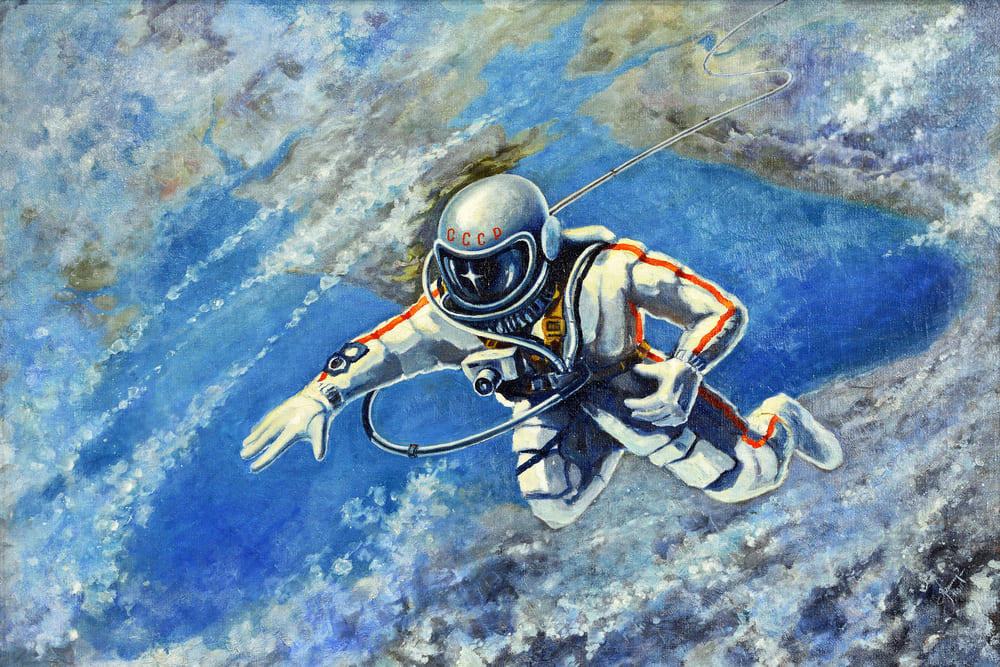The cold vacuum of space, with its infinite expanse and zero gravity, has always beckoned humanity to explore its mysteries. On March 18, 1965, the Soviet Union marked a historic milestone in space exploration with Alexei Leonov’s pioneering feat – the first spacewalk. This groundbreaking event not only showcased the prowess of Soviet space technology but also underscored the relentless human spirit of exploration and innovation.
The prelude to greatness: Soviet space program and the cold war era
The 1960s were defined by the intense geopolitical tensions of the Cold War, which saw the USSR and the USA in a race to achieve space supremacy. The Soviet space program, propelled by the triumph of Yuri Gagarin’s historic first human spaceflight in 1961, sought to maintain its edge over NASA. This ambition laid the groundwork for Voskhod 2, the mission that would propel Alexei Leonov into the annals of space history.
Voskhod 2: the spacecraft and its mission
Voskhod 2, a sophisticated Soviet spacecraft, was equipped with advanced space technology designed for extravehicular activity (EVA). The mission’s primary objective was to demonstrate the feasibility of a human performing tasks outside a spacecraft, a critical step for future long-duration space missions and lunar landings. Leonov, alongside his crewmate Pavel Belyayev, embarked on this daring mission with meticulous preparation and rigorous training.
The heroic feat: Leonov’s extravehicular activity
As Voskhod 2 orbited the Earth, Alexei Leonov prepared for his spacewalk. Clad in an advanced Extravehicular Mobility Unit (EMU), also known as a spacesuit, Leonov exited the spacecraft through a specially designed airlock module. The world watched in awe as he floated freely in the microgravity environment, tethered to Voskhod 2 by a 5.35-meter-long safety line.
Leonov’s spacewalk, which lasted approximately 12 minutes, was not without challenges. The spacesuit, though designed to protect him from the harsh conditions of space, began to stiffen, making it difficult for him to maneuver. His suit inflated due to the vacuum of space, and he had to release some of the pressure to re-enter the airlock. Despite these difficulties, Leonov’s composure and resourcefulness ensured the success of the mission.
Technological marvels: the spacesuit and spacecraft airlock
The success of Leonov’s spacewalk hinged on the sophisticated technology of his spacesuit and the spacecraft’s airlock system. The spacesuit, an intricate life support system, provided oxygen, temperature regulation, and protection from cosmic radiation. The airlock, a pressurized chamber, allowed safe transition between the spacecraft’s interior and the space vacuum, marking a significant advancement in spacecraft engineering.
Challenges in space: zero gravity and the space vacuum
Operating in zero gravity presented unique challenges. The weightlessness experienced during the spacewalk affected Leonov’s movements and required precise control to avoid drifting away from the spacecraft. The space vacuum posed additional risks, with extreme temperatures and lack of atmosphere demanding robust life support systems.
The legacy of Leonov’s spacewalk
Alexei Leonov’s pioneering feat left an indelible mark on space history. His bravery and the mission’s success demonstrated the viability of human spaceflight beyond the confines of spacecraft, paving the way for future extravehicular activities. This achievement also intensified the space race, compelling NASA to accelerate its own EVA programs, leading to the landmark moon landing in 1969.
Space communication: ensuring mission success
Effective space communication was crucial during Leonov’s spacewalk. The spacecraft’s radio contact maintained constant communication with mission control, ensuring real-time monitoring and support. This robust communication system was vital for managing the complexities and risks of the mission.
Space training: preparing for the unknown
The success of Leonov’s EVA was a testament to the rigorous space training undergone by Soviet cosmonauts. This preparation included simulations of weightlessness, technical drills, and emergency procedures, equipping Leonov with the skills and resilience needed for the pioneering mission.
Photographic legacy: capturing the first spacewalk
Leonov’s spacewalk was not only a technical achievement but also a moment captured in space photography. The images of Leonov floating in space became iconic, symbolizing human ingenuity and the relentless quest for exploration. These photographs served as powerful documentation, inspiring future generations of space enthusiasts and scientists.
The cold war rivalry: space supremacy and its implications
The first spacewalk occurred against the backdrop of the Cold War rivalry, with the USSR and the USA vying for space supremacy. This competition spurred significant advancements in aerospace technology and accelerated the pace of space exploration. Leonov’s achievement was a strategic victory for the Soviet Union, reinforcing its position in the space race.
Innovations in spacecraft technology
The technological advancements made during the Voskhod 2 mission extended beyond the immediate success of the spacewalk. Innovations in spacecraft design, life support systems, and extravehicular suits contributed to the broader field of space engineering, influencing subsequent missions and space exploration strategies.
Space mission control: orchestrating the mission
The role of space mission control in orchestrating the Voskhod 2 mission cannot be overstated. The mission operations center coordinated every aspect of the spacewalk, from launch to re-entry, ensuring the safety and success of the mission. This centralized command structure became a model for future space missions.
Future implications: the path forward
Alexei Leonov’s pioneering spacewalk had far-reaching implications for the future of space exploration. It demonstrated the feasibility of human operations outside spacecraft, a critical capability for long-duration missions, space station construction, and planetary exploration. The lessons learned from this mission continue to inform and inspire contemporary space endeavors.
A tribute to human ingenuity
The first spacewalk by Alexei Leonov stands as a testament to human ingenuity, courage, and the relentless pursuit of exploration. This historic achievement not only advanced the frontiers of space technology but also inspired a generation to look towards the stars. As we continue to push the boundaries of space exploration, Leonov’s pioneering feat remains a beacon of what is possible when humanity dares to dream and explore the unknown.


